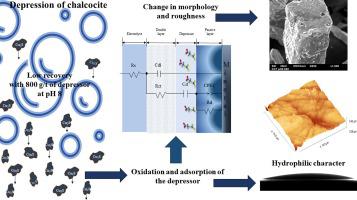当前位置:
X-MOL 学术
›
Miner. Eng.
›
论文详情
Our official English website, www.x-mol.net, welcomes your feedback! (Note: you will need to create a separate account there.)
Evaluation of disodium carboxymethyl trithiocarbonate as a depressant reagent for chalcocite: An electrochemical approach
Minerals Engineering ( IF 4.9 ) Pub Date : 2024-05-03 , DOI: 10.1016/j.mineng.2024.108708 Arait Montoya , Ivan Reyes , Roel Cruz , Isabel Lázaro , Néstor Castillo-Magallanes , Rogelio Flores , Israel Rodríguez
Minerals Engineering ( IF 4.9 ) Pub Date : 2024-05-03 , DOI: 10.1016/j.mineng.2024.108708 Arait Montoya , Ivan Reyes , Roel Cruz , Isabel Lázaro , Néstor Castillo-Magallanes , Rogelio Flores , Israel Rodríguez

|
The effect of the organic depressant disodium carboxymethyl trithiocarbonate (Orfom® D8) on the mineral chalcocite (CuS) was investigated with mixed potentials (Em), microflotation, UV–vis spectrophotometry, electrochemical impedance spectroscopy (EIS) and Fourier transform infrared spectroscopy (FTIR). The mixed potential measurements revealed a decrease in the potential as the depressant dosage was increased, which was attributed to adsorption of the depressant. Microflotation results showed that the mineral recovery percentage decreased from 56.37 % to 5.20 − 11.94 %, depending on the depressant concentration and solution pH. The fits of the experimental data indicated that the depressant was chemically adsorbed, and this was corroborated by EIS studies that indicated an electrochemical mechanism involving the depressant and the mineral. The proposed adsorption mechanism involved oxidation of the depressant for the formation of Cu(D8) and CuD8 complexes on the chalcocite surface in addition to the formation of CuD8 complexes on the oxidized surface (CuS and CuS); thus, these complexes were responsible for depression of the mineral. AFM measurements revealed roughness changes associated with depressant adsorption and surface oxidation of the mineral. Finally, the FT-IR spectra showed that adsorption of the D8 depressant on chalcocite occurred through the trithiocarbonate group, which oriented the carboxylate group away from the mineral surface, thus conferring hydrophilic character. The observed behavior indicated that the Orfom® D8 depressant can be used as a chalcocite depressor in a selective flotation separation stage with an adsorption mechanism different from that proposed for chalcopyrite but with a similar depressor effect.
中文翻译:

羧甲基三硫代碳酸二钠作为辉铜矿抑制剂的评价:电化学方法
通过混合电位 (Em)、微浮选、紫外-可见分光光度法、电化学阻抗谱 (EIS) 和傅里叶变换红外光谱 (FTIR) 研究有机抑制剂羧甲基三硫代碳酸二钠 (Orfom® D8) 对矿物辉铜矿 (CuS) 的影响)。混合电位测量显示,随着抑制剂剂量的增加,电位降低,这是由于抑制剂的吸附。微浮选结果表明,矿物回收率从 56.37% 下降到 5.20 − 11.94%,具体取决于抑制剂浓度和溶液 pH 值。实验数据的拟合表明抑制剂被化学吸附,EIS 研究证实了这一点,表明涉及抑制剂和矿物质的电化学机制。所提出的吸附机制除了在氧化表面(CuS 和 CuS)上形成 CuD8 络合物外,还涉及抑制剂的氧化,从而在辉铜矿表面上形成 Cu(D8) 和 CuD8 络合物;因此,这些复合物导致了矿物的凹陷。 AFM 测量揭示了与抑制剂吸附和矿物表面氧化相关的粗糙度变化。最后,FT-IR 光谱表明 D8 抑制剂在辉铜矿上的吸附是通过三硫代碳酸酯基团发生的,该基团使羧酸酯基团远离矿物表面,从而赋予亲水特性。观察到的行为表明,Orfom® D8 抑制剂可在选择性浮选分离阶段用作辉铜矿抑制剂,其吸附机制与针对黄铜矿的吸附机制不同,但具有类似的抑制剂效果。
更新日期:2024-05-03
中文翻译:

羧甲基三硫代碳酸二钠作为辉铜矿抑制剂的评价:电化学方法
通过混合电位 (Em)、微浮选、紫外-可见分光光度法、电化学阻抗谱 (EIS) 和傅里叶变换红外光谱 (FTIR) 研究有机抑制剂羧甲基三硫代碳酸二钠 (Orfom® D8) 对矿物辉铜矿 (CuS) 的影响)。混合电位测量显示,随着抑制剂剂量的增加,电位降低,这是由于抑制剂的吸附。微浮选结果表明,矿物回收率从 56.37% 下降到 5.20 − 11.94%,具体取决于抑制剂浓度和溶液 pH 值。实验数据的拟合表明抑制剂被化学吸附,EIS 研究证实了这一点,表明涉及抑制剂和矿物质的电化学机制。所提出的吸附机制除了在氧化表面(CuS 和 CuS)上形成 CuD8 络合物外,还涉及抑制剂的氧化,从而在辉铜矿表面上形成 Cu(D8) 和 CuD8 络合物;因此,这些复合物导致了矿物的凹陷。 AFM 测量揭示了与抑制剂吸附和矿物表面氧化相关的粗糙度变化。最后,FT-IR 光谱表明 D8 抑制剂在辉铜矿上的吸附是通过三硫代碳酸酯基团发生的,该基团使羧酸酯基团远离矿物表面,从而赋予亲水特性。观察到的行为表明,Orfom® D8 抑制剂可在选择性浮选分离阶段用作辉铜矿抑制剂,其吸附机制与针对黄铜矿的吸附机制不同,但具有类似的抑制剂效果。











































 京公网安备 11010802027423号
京公网安备 11010802027423号